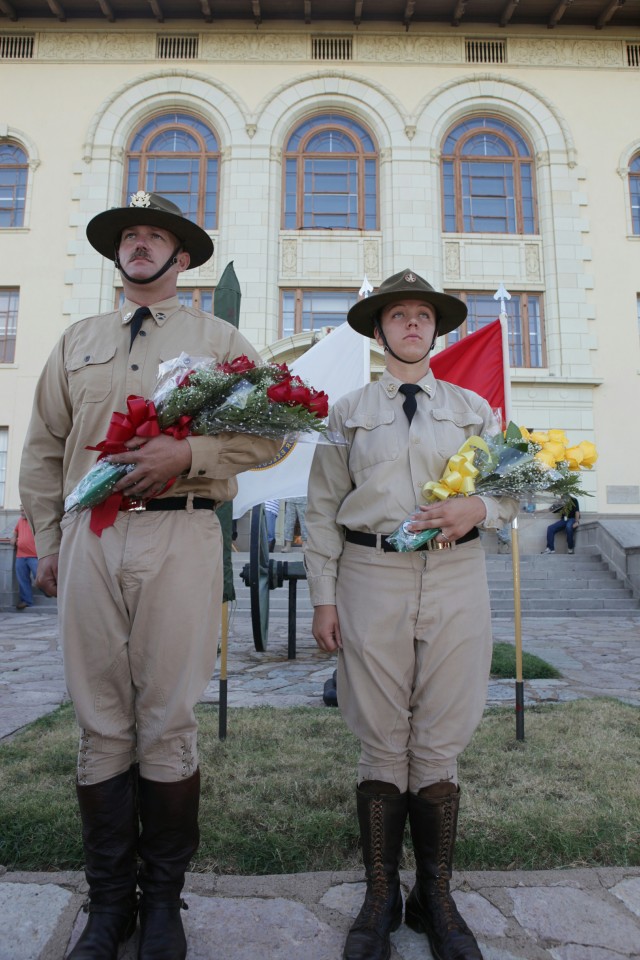
FORT SILL, Okla.--Last month at the Lawton Rangers Rodeo, the Fort Sill Field Artillery Half Section performed a demonstration in the opening ceremony.
The Half Section's team of six-hitched horses pulled a gun section, galloping around the arena. It was the fastest the team ever rides, said a Half Section member. The Soldiers also fired the unit's cannon. During the four days of rodeo, the Soldiers went on to do three more performances.
"The crowd loved it. We could barely hear each other as we tried to communicate," said Sgt. Matthew Hamilton, Half Section noncommissioned officer in charge, referring to the loud cheers. "It turned out very well."
The rodeo was one of nearly 140 events the ceremonial unit performs each year as it historically recreates artillery traditions of World War I cannoneers.
The Half Section's events include changes of command, retirements, cannon salutes, funerals, retreat and reveille, and demonstrations throughout the year.
Half Section Soldiers delivered Santa Claus so he could help light the post Christmas tree in December, they fired the unit's Model 1897 French 75mm field gun to start the Freedom's Thunder Motorcycle Rally in May and they kept particularly busy with command changes during summer.
Eight volunteer Soldiers and a civilian section chief make up the Half Section, which originated here in 1969.
'Half section' refers to the gun section of horse-drawn field artillery. A 'full section' would consist of the gun section, as well as another six-horse hitch pulling the ammunition caisson, said Gerald Stuck, Half Section chief.
Eight Fort Sill units provide volunteer Soldiers for the year-long special duty detail, said Spc. Spencer Herness. To be considered, Soldiers must be able to ride a horse, jump on a limber (the two-wheeled front piece of a gun carriage), stack hay and carry 50-pound feedbags 200 yards, he said.
Spc. Alicia Redding has been around horses all her life because her mother trained horses in Huxley, Iowa. Redding had heard of the Half Section even before she was assigned to Fort Sill.
"It's awesome," Redding said, referring to the duty. She came to the unit from the 3rd Battalion, 2nd Air Defense Artillery here.
Redding is a swing driver the middle rider on the six-horse team and who helps turn the team. She is learning to be a lead driver, who rides on the front horse and steers.
"It's a big change going from one position to another," she said.
The third rider is the wheel driver, who controls the pulling and stopping of the limber, Herness said.
Growing up in Stevensville, Mont., Pfc. Jeremy Thomas said he had a mustang-cross and all the neighbors had horses, too.
"So this (Half Section duty) is pretty much home for me," said Thomas, who was a fueler with the 100th Brigade Support Battalion, before coming to the unit.
Pvt. Gilbert Valdez, from Phoenix, did not grow up around horses. Valdez has been on the job for about one month and said that he volunteered because it was different.
"I like it; it's fun," said Valdez, who has performed in three ceremonies.
But there's more to the job than just riding the unit's dozen horses.
The Soldiers are responsible for maintaining all the Model 1916 field artillery harnesses, Model 1904 McClellan artillery saddles and associated gear, such as bridals and collars.
The Half Section has its own leather shop and the Soldiers repair and refurbish all the saddles and harnesses.
"We are capable of repairing everything on this harness," Herness said, holding one. "We've a cutting, thinning and sewing machines, and we have all the hand tools."
Although they are not farriers (horse shoers) or blacksmiths, a couple Soldiers can replace thrown shoes, said Pvt. Patrick Snodgrass. Once a month a farrier visits to replace worn shoes. Also, Herness, who is an Army welder, welds borium onto horse shoes for traction.
A typical day for the Soldiers begins at 6 a.m. with horses being fed and the Soldiers then cleaning the stables. Horses are then taken outside where they are groomed.
The grooming includes cleaning the horses' hooves and applying hoof dressing, which helps the hoof retain moisture to prevent cracking, Herness said. Afterward the horses are released in a paddock.
The Soldiers also train the horses. Shepard, a quarter horse who joined the Half Section in August, will first be ridden as a single mount to get him used to band music and cannon fire, Stuck said. Then Soldiers will work with him on the harness and eventually the limber to get him used to pulling.
"It will be months before he goes into a ceremony (as part of team)," Stuck said.
On an event day, the Soldiers are at work at 4 a.m. to begin preparing for the ceremony. This can take five to six hours, said Snodgrass.
"This includes grooming the horses, feeding them, putting the harnesses on them and making sure the harnesses are still shined, shining the gun and limber and hooking them up, showing up to the place of duty and warming up the horses," he said. "Then we do our ceremony."
If they are not working with the horses, cleaning equipment or unloading hay, the Soldiers maintain the units seven acres. This includes mowing and policing the grounds.
What's the best part of the job'
"I like working with the horses," said Hamilton, who has been with the Half-Section for 10 months. "It's fun getting away from the day-to-day routine of the regular Army."

Social Sharing